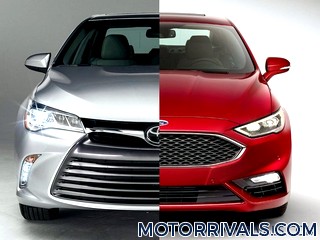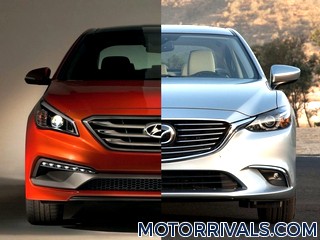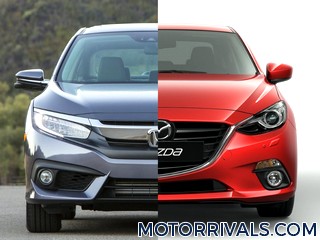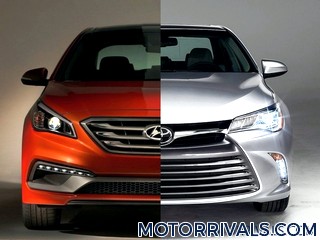2017 Nissan Sentra vs 2017 Honda Civic
Nissan Press Release Highlights
Key features of the Sentra exterior include a new front fascia, grille, fenders, hood and signature boomerang-shaped headlights. New LED low-beam headlights with LED signature accents are offered on Sentra SR and Sentra SL grades. In the rear, a new fascia with redesigned boomerang-shaped taillights adds a more premium appearance. As in previous years, Sentra's exterior design is elegant, modern and refined, reflecting a "professional" character targeted at upwardly bound buyers who aspire to drive something more upscale than other designs in the segment. Exterior features include chrome door handles and chrome window accents and available heated outside mirrors with integrated turn signals. The new Nissan Sentra SR Turbo is expected to help keep the sales momentum going by expanding its market reach. In addition to the new SR Turbo (6MT and Xtronic), the 2017 Nissan Sentra is offered in four other grade levels: Sentra S, SV, SR and SL (Xtronic).
Powertrain
At the heart of the SR Turbo is its new 1.6-liter Direct Injection Gasoline (DIGTM) turbocharged engine that delivers a 50 percent horsepower increase from the normally aspirated 1.8-liter Sentra SR powerplant. Rated at 188 horsepower and 177 lb-ft of torque, the new SR Turbo engine offers 64 more horsepower and 52 more lb-ft of torque than non-turbo 2017 Sentra grades.All 2016 Sentra models utilize a fuel-efficient 1.8-liter 4-cylinder engine mated to an advanced Xtronic transmission with sub-planetary gear. A 6-speed manual transmission is also available with the Sentra S grade. The advanced 1.8-liter DOHC 4-cyinder engine offers a longer stroke than typical engines in its class, resulting in improved combustion speed and efficiency. The engine is equipped with a twin Continuously Variable Timing Control (CVTC) system which modulates both the intake and exhaust valve opening time. The engine is rated at 130 horsepower and 128 lb-ft of torque.
The Xtronic transmission offers a wide gear ratio range of 7.3:1 through use of a sub-planetary gear and smaller pulleys, resulting in high-speed fuel efficiency and responsive acceleration. The Xtronic's acceleration feel is enhanced with a D-mode step shift program that simulates shifts, giving a more natural acceleration feeling without holding a high rpm constant, letting rpms build as speed builds. For 2016, the D-Step Logic Control has been revised to help provide enhanced drivability with a more stable, natural and crisper shift feel (versus the previous design).
To help handle the increased power and torque, the new Sentra SR Turbo also receives an enhanced body structure, revised steering system, larger front disc brakes, new 6-speed manual or Xtronic transmission with manual mode and unique suspension tuning.
Chassis
The 2016 Sentra also delivers enhanced performance and handling through a retuned suspension design featuring a 10 percent increase in spring and damper rates (from the prior model year), as well as enhanced body stiffness for improved roll and body control through adoption of a new front tunnel stay similar to that used on the JUKE NISMO RS. The Sentra suspension features an independent strut front layout with stabilizer bar, torsion beam rear axle with integrated stabilizer bar.Steering feel and response has also been improved through use of optimized Electric Power Steering (EPS) mapping in conjunction with the revised suspension and new tire design. A power-assisted vented front disc/rear drum braking system (4-wheel disc brakes are available) is standard along with retuned vehicle-speed-sensitive electric power steering.
Technology
The 2017 Sentra SR Turbo includes a standard power sliding glass moonroof and SR Turbo badging. The SR Turbo Premium Package, the only option package available with the SR Turbo, includes Blind Spot Warning (BSW), Rear Cross Traffic Alert (RCTA), leather-appointed seating and Bose® Premium audio system with eight speakers.The standard Sentra audio system is an AM/FM/CD system with four speakers and USB connection for iPod® and other compatible devices. Other available audio systems include a 6-speaker AM/FM/CD system with 5.0-inch color display. Also available is SiriusXM® Satellite Radio (SiriusXM® subscription required, sold separately), while Bluetooth® Hands-free Phone System is standard on all grades. The Sentra offers advanced technology features that help owners stay connected - including NissanConnect with Mobile Apps, which is standard on SV and SR grades and includes iHeartRadio, Pandora® and Facebook.
Safety
A number of Nissan's advanced Safety Shield Technologies are now available on Sentra for the first time for the 2016 model year - Forward Emergency Braking (FEB), Intelligent Cruise Control (ICC), Blind Spot Warning (BSW) and Rear Cross Traffic Alert (RCTA). Intelligent Cruise Control (ICC) and Forward Emergency Braking (FEB) are combined as part of the new Technology Package offered for Sentra SR and SL grades. Blind Spot Warning (BSW) and Rear Cross Traffic Alert (RCTA) are included in the Navigation Package (SV and SR grades) and are standard on Sentra SL.In addition, Sentra's list of standard safety and security features include the Nissan Advanced Air Bag System (AABS) with dual-stage supplemental front air bags with seat belt and occupant classification sensors; front seat-mounted side impact supplemental air bags; roof-mounted curtain side impact supplemental air bags with rollover sensor for front and rear-seat outboard occupant head protection; 3-point front and rear seatbelts, front seat belts with pre-tensioners and load limiters and adjustable upper anchors; and LATCH System (Lower Anchors and Tethers for CHildren).
Honda Press Release Highlights
Virtually everything about the 2016 Civic Sedan is new – an all-new vehicle architecture, sporty and sophisticated new interior and exterior styling, a more spacious and high-quality cabin, two advanced new engines, and a host of new premium features and technologies.
Further, with the addition of Honda Sensing™ safety and driver-assistive technologies and the first application of Honda turbo engine technology to Civic, the 2016 Civic Sedan offers buyers a wider range of options than ever before. Civic models powered by the new 2.0-liter i-VTEC™ engine are designated as the Civic LX and EX trims. Civic models powered by the new turbocharged 1.5-liter engine are designated as the EX-T, EX-L (with leather-trimmed interior) and new line-topping Civic Touring, which reaches higher into the upper end of the compact car market than ever before.
Powertrain
Powering the 2016 Civic Sedan are two all-new engines, both designed to provide highly refined, responsive and fuel-efficient performance. Civic Sedans in LX and EX trim are powered by a 2.0-liter DOHC, 16-valve, port-injected, inline 4-cylinder engine with i-VTEC™ valvetrain producing a peak 158 hp at 6,500 rpm and 138 lb-ft. of torque at 4,200 rpm, making it the most powerful base engine ever offered in Civic. The new 2.0-liter engine is mated to a sporty continuously variable transmission (CVT) with Honda G-Design shift control, or a quick-shifting 6-speed manual transmission.
Civic Sedans in EX-T, EX-L and Touring trim are powered by an all-new turbocharged 1.5-liter DOHC, direct-injected and inline 4-cylinder engine with variable cam timing (VTC) and electronic waste gate, turning out 174 hp at 5,500 rpm and peak torque of 162 lb-ft. from 1,800 to 5,500 rpm. The 1.5-liter turbo engine is mated to a new CVT that combines with the low-inertia turbo, VTC and electronic waste gate to optimize power delivery across the engine's full operating range.
Both engines feature a wide array of friction-reduction design and engineering features that support both high performance and high fuel efficiency. These two ultra-efficient engines, married to the 2016 Civic's light, rigid and highly aerodynamic body, help the Civic garner anticipated class-leading EPA-estimated fuel economy ratings of 31/41/35 mpg (city/highway/combined)1 for the 2.0-liter engine with CVT and 31/42/35 mpg1 for the 1.5-liter turbo with CVT.
Chassis
- Ultra-rigid body with
59-percent application of high-strength steel and 14-percent application
of ultra-high-strength steel (up from 55 percent and 1 percent,
respectively, in the previous model) – the most extensive use of
high-tensile steel ever in a Civic
- 68-pound reduction in unibody
weight versus the previous Civic Sedan, despite its larger size and
greater stiffness
- ACE™ body structure with new crash stroke design
(Honda and Civic first) for improved collision performance in a
sportier, more compact front frame design
- Ultra-high-strength steel
B-pillars and rear frame rails with selectively-tempered "soft zones"
for reduced weight and enhanced collision performance (Civic first)
- Ultra-rigid 590-mpa high-strength-steel floor for enhanced collision performance and improved ride quality (Civic first)
- New multi-link independent rear suspension
- Hydraulic
compliance bushings for premium levels of ride quality and road
vibration isolation (Civic first)
- Larger stabilizer bars with bonded
bushings for more refined body control (Civic first)
- Rigid aluminum
rear damper brackets for improved ride quality (Civic first)
- Agile
Handling Assist brake torque vectoring for cornering precision and
stability (Civic first)
- Dual-pinion electric power steering with variable gear ratio for improved steering feel and maneuverability (Civic first)
Technology
- Remote Engine start
- Electronic parking brake
- Walk Away Door
Locking
- Dual-zone automatic climate control
- Rain-sensing wipers
- Display
Audio with Apple CarPlay® and Android Auto
- Raising intuitive operation and digital connectivity to the next level, the 2016 Civic Sedan in EX and above trims incorporates a new 7-inch Display Audio touchscreen that serves as the nerve center for control of audio, HVAC and other functions. The new Display Audio is integrated with new Apple CarPlay®3 and Android Auto2 platforms, providing seamless integration of smartphone features and functions, including app-based navigation, streaming audio, voice-controlled search capabilities, and access to a host of Apple- or Google-approved smartphone apps.
Safety
The Civic utilizes advanced front, side and side curtain airbag technology, including a driver's front airbag with new spiral stitching for an improved deployment profile; SmartVent® technology for the driver and front passenger side airbags; and a new front passenger airbag with safety vent technology that can mitigate the possibility of injury from airbag deployment when the passenger is "out of position." These systems work in conjunction with the advanced body structure and optimally tuned interior components to help mitigate injuries in a collision.






















